
|

|
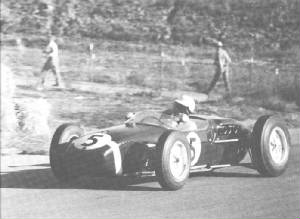
Lotus 18
The Lotus 18 was designed by Colin Chapman for use by in F1 and F2. It was the first mid engined car built by the team,
and its most successful early design after Chapman decided to switch from his early and unsuccessful front engined cars. It
was introduced for the 1960 F1 and F2 seasons. The car was a piece of classic Chapman design being extremely light and simple;
the body was made up of lightweight panels bolted onto a spaceframe chassis. Thus the car was rigid and strong. It was powered
initially by a 2.5 litre Coventry Climax V8, then by a 1.5 litre Climax when new engine rules came into force in 1961.
The car took Lotus' first F1 victory, albeit by private entrant Rob Walker who leased the car from Chapman. Driven by
Stirling Moss at the 1960 Monaco Grand Prix, the car took a dominant win. It was an early taste of things to come for onlookers.
Moss also won the American Grand Prix at the end of the season, helping Lotus finish third in the constructors' championship.
Moss took victory in a legendary race at Monaco the following year, beating off the more powerful and faster Sharknose Ferraris
and then won at the fearsome Nurburgring in changeable weather, while Innes Ireland tok a third win in the USA to help Lotus
finish second in the constructors' championship that year. The car was notable for giving Jim Clark his first Grand Prix start
in 1960.
The 18 was replaced by the Lotus 25 in 1962.
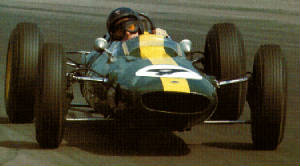
Lotus 25
The Lotus 25 was designed by Colin Chapman for the 1962 Formula 1 season. It was a revolutionary design, the first fully
stressed monocoque chassis to appear in F1. An early brainchild of Chapman's fertile mind, the original sketches for the car
were made on napkins while Chapman discussed his idea with Lotus chief Len Terry while they were dining out!
The monocoque made the car more rigid and structurally stronger than typical F1 cars of the period. As a result, the car
was extremely low and narrow. The driver appeared to be lying down while at the wheel, giving the car the nickname 'The Bathtub.'
It was powered by a 1500cc Coventry Climax V8. Such was the effect the 25 had on motor racing, even today's modern F1 cars
are designed to the 25's basic principles.
Private team owners, who had been buying Lotus chassis were disgruntled by the fact that Colin Chapman had promised the
latest chassis design to them. Those teams, including Rob Walker Racing were given Lotus 24 cars, while the works team had
exclusive use of the 25 for Jim Clark and Trevor Taylor. When the car first appeared at the Dutch Grand Prix the futuristic
25 was inspected by John Cooper who asked Chapman where he had put the chassis in the car.
The car gave Jim Clark his first grand prix victory at Spa that year. He followed by taking another win in the USA which
put him in contention for the title, but at the final race, a much publicised engine seizure cost him the title to Graham
Hill.
Clark gained his revenge the following year, winning his first world championship in the 25, by winning 7 races, Belgium,
France, Holland, Britain, Italy, South Africa and Mexico. Lotus also won its first constructors' championship. The 25 was
used during the 1964 season, winning a further 3 races with Clark. At the final race in Mexico, just as in 1962 the Climax
engine developed an oil leak and with literally a lap to run Clark coasted to a halt in sight of world championship victory,
this time conceding to John Surtees.
Clark went on to take the car's final win at the 1965 French Grand Prix before it was replaced by the Lotus 33. The Lotus
25 won 14 races and 18 pole positions.
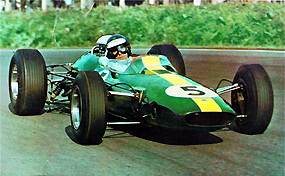
Lotus 33
The Lotus 33 designed by Colin Chapman, was a Formula One car built by Team Lotus. Its development was based on the earlier
Lotus 25 model, taking the monocoque chassis design to new development heights. The 33 was again powered by the 1500cc Climax
engine. The 33 was almost identical to the 25, but had suspension designed around newer, wider tyres. The car more more rigid
and was simpler to build than its predecessor.
Introduced for the 1965 season, Clark took the 33 to victory in its first appearance at the South African Grand Prix before
taking the car to four more wins to take his second world championship.
Compared to the 25, the Climax engine had an increase in power (about 210 - 220 BHP compared to the older Climaxes in
the 25, which gave about 200 BHP). However the extra power sacrificed reliability, and Clark retired from the final 3 races
of 1965, fortunately after he'd wrapped up the title. The 33 was pressed into service with a bored out 2 litre Climax V8 for
the early races of 1966, until the 3 litre Lotus 43 was ready.
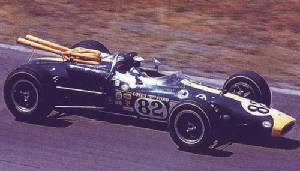
Lotus 38
The Lotus 38 was designed by Colin Chapman and Len Terry as Lotus 1965 entry for the Indianapolis 500. It was an evolution
of the previous Lotus 29 Indy design, and was powered by a four-cam Ford V8 fuel injected engine giving out a round 500 bhp.
The engine was mid-mounted, improving the weight distribution and giving it good handling. The suspension was specially designed
with suspension arms of unequal length, better suited for the ovals. The 38 was significantly larger than F1 cars of the time,
but was dwarfed by the massive American roadsters.
Jim Clark qualified on the first row, and race was a walkover for him, as he led all but 10 laps, and won by two laps
from A.J. Foyt and Mario Andretti. It was payback for losing the race in 1963, when Clark felt that Parnelli Jones' oil spewing
car should have been black flagged.
The 38 had proved that mid engined cars could make the grade at the Brickyard, and the days of the front engined roadsters
were effectively over. Lotus returned with the 38 in 1966, but conceded victory to Graham Hill in a Lola.

|

|

|

|

|

|

|

|

|

|

|

|

|

|

|

|

Lotus 43
The Lotus 43 was designed for the 1966 season by Colin Chapman. The 1966 season was the first season where 3 litre engines
were permitted. As a result, Chapman and Lotus made a deal for use of BRM's new H 16 engine as well as using new, wider tyres
better able to put the power of the engine down on to the track.
The engine on paper was technically advanced and powerful, and Chapman had hopes that it would power his cars to another
successful season. Alas, it was not to be. The first sign of trouble was when the new engine arrived and it required four
men to lift it from the truck. The engine proved to be overweight, unreliable and was unable to produce the promised power.
Jim Clark didn't score any points until mid season. Clark was able to turn his fortunes around and won the American GP at
Watkins Glen at the end of the season, thereby winning the H 16's only race. In 1967 the 43 made its final start in the South
African GP at the Kyalami circuit, where Clark again retired the car. The 43 chassis was an excellent design let down by a
poor powerplant, and Chapman was left to rue his choice as he had been offered Repco engines for 1966, which went on to take
the world championship that year for Brabham. The 43 was replaced by the legendary Lotus 49 for 1967.
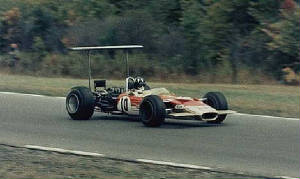
Lotus 49
The Lotus 49 was a Formula One racing car designed by Colin Chapman and Maurice Phillipe for the 1967 F1 season. It was
designed around the Cosworth DFV engine that would power most of the Formula One grid through the 1970s and was the first
successful Formula One car to feature the engine as a structural member.
Jim Clark won on the car's debut in 1967, and it would also provide him with the last win of his career in 1968. Graham
Hill went on to win that year's title and the car continued winning races until 1970.
After a difficult first year for Lotus in the 3 litre formula, Chapman went back to the drawing board and came up with
a design that was both back to basics, and a leap ahead. Taking inspiration from earlier designs, particularly the Lotus 43
and Lotus 38 Indycar, the 49 was the first F1 car to be powered by the now-famous Ford Cosworth DFV engine after Chapman convinced
Ford to build an F1 powerplant.
The 49 was a revolution in Formula 1 because of its then-unique configuration (seen first with the H16 engine in the Lotus
43 and BRM P83) where the specially-designed engine became a structural part of the chassis, bolted to the monocoque at one
end and the suspension and gearbox at the other. Since then virtually all Formula 1 cars have been built this way, right up
to the present day.
The 49 was a testbed for several new pieces of racecar technology and presentation. Lotus was the first team to use aerofoil
wings, which appeared partway through 1968. Originally these wings were bolted directly to the suspension and were supported
by slender struts. The wings were mounted several feet above the chassis of the car for effective use in clean air, however
after several breakages which led to near fatal accidents, the high wings were banned and Lotus was forced to mount the wings
directly to the bodywork.
In testing, Graham Hill found the 49 easy to drive and responsive, but the power of the Ford difficult to handle at first.
The V8 would give sudden bursts of power that Hill had reservations about. However, Jim Clark won its debut race at Zandvoort
with ease and took another 3 wins during the season, but early unreliability with the DFV ended his championship hopes. It
had teething problems in its first race for Graham Hill, and it had plug trouble at the Belgian Grand Prix, held on the 8.76
mile (14.73 kilometer) Spa-Francorchamps circuit for Jim Clark. Jim Clark and Graham Hill fell victim to the teething problem
at the French Grand Prix, held at the Le Mans Bugatti Circuit (a smaller circuit using only part of the track used for the
Le Mans 24 Hours), and lost to Jack Brabham. Jim Clark then ran out of fuel at Monza during the Italian Grand Prix. However
it was felt that 1968 would be a better year after Cosworth perfected the design, and it was obvious the DFV and the design
of the Lotus 49 was the way forwards.
In 1967 the Lotus 49 was painted in British racing green but from the 1968 Monaco race, the 49 was painted red, white
and gold, the colours of Gold Leaf cigarettes after Chapman signed a lucrative sponsorship deal. It was the first sign of
big money entering the sport.
Clark won the first race of the 1968 season, the South African Grand Prix and the Tasman Series in Australia, but was
tragically killed in an F2 race at Hockenheim. Graham Hill took over as team leader and won his second World Championship
title, repeating his 1968 win at Monaco. The 49 also took Jochen Rindt to his first victory in 1969 at Watkins Glen, New York,
before he drove the type to its last win in the 1970 Monaco Grand Prix.
The 49 was intended to be replaced by the Lotus 63 midway through 1969, but when that car proved to be a failure, the
49 was pressed into service until a suitable car could be built. The 49 took 12 wins, contributed to 2 driver and constructors'
world championships, before it was replaced by the Lotus 72 during 1970.

Lotus 63
The Lotus 63 was an experimental F1 design, designed by Colin Chapman and Maurice Phillipe for the 1969 season. Chapman's
reasoning behind the car was that the 3 litre engines introduced in 1966 would be better served by building a car that could
take full advantage of its power while retaining the Lotus 49's simplicity.
Lotus 63 driven by John Miles
The chassis was designed around a four wheel drive system, a revolution at the time, as four wheel drive had only been
used on military vehicles and had not even been used on ordinary road cars at that time. The car was an evolution of the 49,
but featured wedge shaped rear bodywork and integrated wings, which would be used to great effect in the Lotus 72.
John Miles, Lotus' third driver was entrusted the task of developing the car, while Graham Hill and Jochen Rindt used
the 49 in the early races of 1969. The car proved extremely difficult to drive and set up, and the four wheel drive system
was especially problematic. After a single test run, Hill flatly refused to drive the car again stating it was a 'deathtrap,'
as did Rindt, who agreed with Hill after taking the car to its best result, 2nd in the Oulton Park Gold Cup. This infuriated
Chapman as he saw the 63 as another quantum leap ahead of its rivals, just as its predecessors had been.
The car was entered at the 1969 British Grand Prix as a test run. Whilst Rindt finished second to Jackie Stewart in the
older 49, Miles could only bring the 63 home in 10th place, confirming the car's uncompetitiveness. After several other fruitless
outings, the 63 and its four wheel drive technology was abandoned, but parts of the chassis design were worked into the brilliant
Lotus 72, which debuted in 1970.
Like the Lotus 88, the car proved to be a huge white elephant for Lotus, but it paved the way for better models to follow.

Lotus 56
The Lotus 56 was designed by Maurice Phillipe as Lotus 1968 entry in the Indianapolis 500, replacing the successful Lotus
38. Colin Chapman's team had again produced an innovative design. The car was shaped like a wedge on wheels, in the same vein
as the later Lotus 72, which was also designed by Phillipe and Chapman. The engine of the 56 was also noteworthy, as it was
powered by a Pratt & Whitney gas turbine engine which produced over 500 bhp. To get the best out of the power produced,
the 56 was fitted with four wheel drive, something also used on the Lotus 63 without success.
Jim Clark was enthused about the car in testing, but he was tragically killed in April of 1968 before he could qualify
the car at Indy. Nevertheless, Graham Hill, Joe Leonard and Art Polland were entered for the race, with Leonard claiming pole
position. In the race Leonard was leading with ease with just a handful of laps to go when the gas turbine engine failed.
Lotus' innovation had incurred the wrath of the governing body of American motorsport, USAC who deemed turbine powered cars
and four wheel drive illegal shortly after, much to Chapman's frustration.
Undeterred by USAC's decision to call the 56's technology illegal, Chapman developed the car as a potential F1 machine
after the faliure of the Lotus 63, but while the car was promising, it was too heavy and too overcomplicated for the F1 world.
Emerson Fittipaldi tried the car in the 1971 Race of Champions. During wet practice the 56 was far and away the fastest car
on the track, but the race was held in dry weather and the car was lost in midfield. Fittipaldi used the car again in that
year's Italian Grand Prix and managed to bring the fragile design home in 8th. By then Colin Chapman decided to cut his losses
and abandoned the 56, the four wheel drive concept and the gas turbine engine to concentrate on the Lotus 72, which went on
to win the drivers' and constructors' championships for Lotus in 1972.
|

|

|

